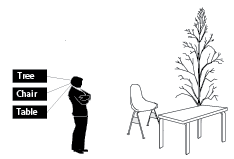The Symbolic Data Assumption
The elements of thinking are represented in discrete, symbolic form. Beliefs, desires, goals, values, plans, etc are represented by such data and by their combination into higher order symbol structures like knowledge bases.

History of the Symbolic Data Assumption
The idea that the world can be understood as composed of discrete elements has a long history in the philosophical tradition.
Plato, for example, believed that all true knowledge (knowledge of piety, and justice, the good, etc) must be statable in explicit definitions that would act like rules telling us how to behave. Rene Descartes proposed that certainty and knowledge could only be obtained by relying on what he called 'clear and distinct ideas', that is, ideas that are clear in themselves and distinct from other ideas.
Gottfried Leibniz, one of the originators of the idea that a machine could think, also introduced the notion of a monad, which, as a basic component of reality "is nothing but a simple substance that enters into composites -- simple, that is, without parts." Leibniz, 1714, p.1.
The British empiricists (notably, John Locke, George Berkeley, and David Hume) held that all knowledge comes to us through experience in the form of discrete 'simple ideas' which combine to form 'complex ideas'. The notion that ideas are discrete continued in the work of Hume, who claimed that "every distinct perception which enters into the composition of the mind, is a distinct existence, and is different, distinguishable, and separable from every other perception, either contemporary or successive" (1739, p.259).
In the 19th century, but Gottlob Frege invented the first complete formalisation of predicate predicate logic. Frege regarded thoughts as discrete entities composed of concepts and relations between them. In this century, Bertrand Russell founded logical atomism, in which the world is understood in terms of atomic propositions that are either true or false. Ludwig Wittgenstein articulated his early version of logical atomism as follows. "1. The world is all that is the case. 1.1 The world is the totality of facts, not things. 1.11 The world is determined by the facts, and by their being all the facts." (1922, p.5).
Much of this history was first recounted (in the context of artificial intelligence) by Dreyfus (1972).